Evaluation of the Economic Potential of Photovoltaic Power Generation in Road Spaces
Abstract
:1. Introduction
2. Materials and Methods
2.1. Introduction of Data Sources
2.1.1. Study Area
2.1.2. Data Sources
2.2. Research Methods
2.2.1. Geographic Potential Calculation
- Freeway and ordinary road
- 2.
- Service area (land used for transportation facilities)
- 3.
- Railway
- 4.
- Railway station (land used for railways)
2.2.2. Calculation of Technical Potential
2.2.3. Calculation of Economic Potential
3. Results
3.1. Area of Available Road Space for PV
3.2. Evaluation of PV Power Generation in Road Space
3.3. Evaluation of the Economic Potential of PV Power Generation in Road Space
4. Discussion and Conclusions
Author Contributions
Funding
Institutional Review Board Statement
Informed Consent Statement
Data Availability Statement
Conflicts of Interest
References
- Bódis, K.; Kougias, I.; Jäger-Waldau, A.; Taylor, N.; Szabó, S. A high-resolution geospatial assessment of the rooftop solar photovoltaic potential in the European Union. Renew. Sustain. Energy Rev. 2019, 114, 109309. [Google Scholar] [CrossRef]
- Mainzer, K.; Killinger, S.; Mckenn, R.; Fichtner, W. Assessment of rooftop photovoltaic potentials at the urban level using publicly available geodata and image recognition techniques. Solar Energy 2017, 155, 561–573. [Google Scholar] [CrossRef]
- Sahu, A.; Yadav, N.; Sudhakar, K. Floating photovoltaic power plant: A review. Renew. Sustain. Energy Rev. 2016, 66, 815–824. [Google Scholar] [CrossRef]
- Mittal, D.; Saxena, B.K.; Rao, K. Floating solar photovoltaic systems: An overview and their feasibility at Kota in Rajasthan. In Proceedings of the 2017 International Conference on Circuit, Power and Computing Technologies (ICCPCT), Kollam, India, 20–21 April 2017. [Google Scholar]
- Xiao, J.; Yao, Z.; Qu, J.; Sun, J. Research on an optimal site selection model for desert photovoltaic power plants based on analytic hierarchy process and geographic information system. J. Renew. Sustain. Energy 2013, 5, 023132. [Google Scholar] [CrossRef]
- Wang, Y.; Zhou, S.; Huo, H. Cost and CO2 reductions of solar photovoltaic power generation in China: Perspectives for 2020. Renew. Sustain. Energy Rev. 2014, 39, 370–380. [Google Scholar] [CrossRef]
- IEA. Global Energy Review 2020: The Latest Trends in Energy and Emissions in 2020. 2021. Available online: https://www.iea.org/reports/global-energy-review-2030 (accessed on 22 July 2022).
- Pan, H.; Qi, L.; Zhang, Z.; Yan, J. Kinetic energy harvesting technologies for applications in land transportation: A comprehensive review. Appl. Energy 2021, 286, 116518. [Google Scholar] [CrossRef]
- Pei, J. Progress of highway engineering and generation upgrading of highway transportation system. China J. Highw. Transp. 2018, 31, 1. [Google Scholar]
- Lameirinhas, R.A.M.; Torres, J.P.N.; Cunha, J.P.D.M. A Photovoltaic Technology Review: History, Fundamentals and Applications. Energies 2022, 15, 1823. [Google Scholar] [CrossRef]
- Cieslik, W.; Szwajca, F.; Zawartowski, J.; Pietrzak, K.; Rosolski, S.; Szkarlat, K.; Rutkowski, M. Capabilities of nearly zero energy building (nzeb) electricity generation to charge electric vehicle (ev) operating in real driving conditions (rdc). Energies 2021, 14, 7591. [Google Scholar] [CrossRef]
- Wadhawan, S.R.; Pearce, J.M. Power and energy potential of mass-scale photovoltaic noise barrier deployment: A case study for the US. Renew. Sustain. Energy Rev. 2017, 80, 125–132. [Google Scholar] [CrossRef]
- Zhong, T.; Zhang, K.; Chen, M.; Wang, Y.; Zhu, R.; Zhang, Z.; Yan, J. Assessment of solar photovoltaic potentials on urban noise barriers using street-view imagery. Renew. Energy 2021, 168, 181–194. [Google Scholar] [CrossRef]
- Jung, J.; Han, S.; Kim, B. Digital numerical map-oriented estimation of solar energy potential for site selection of photovoltaic solar panels on national highway slopes. Appl. Energy 2019, 242, 57–68. [Google Scholar] [CrossRef]
- Deshmukh, S.S.; Pearce, J.M. Electric vehicle charging potential from retail parking lot solar photovoltaic awnings. Renew. Energy 2021, 169, 608–617. [Google Scholar] [CrossRef]
- Ma, T.; Yang, H.; Gu, W.; Li, Z.; Yan, S. Development of walkable photovoltaic floor tiles used for pavement. Energy Convers. Manag. 2019, 183, 764–771. [Google Scholar] [CrossRef]
- Liu, Z.; Yang, A.; Gao, M.; Jiang, H.; Kang, Y.; Zhang, F.; Fei, T. Toward feasibility of photovoltaic road for urban traffic-solar energy estimation using street view image. J. Clean. Prod. 2019, 228, 303–318. [Google Scholar] [CrossRef]
- Tulpule, P.J.; Marano, V.; Yurkovich, S.; Rizzoni, G. Economic and environmental impacts of a PV powered workplace parking garage charging station. Appl. Energy 2013, 108, 323–332. [Google Scholar] [CrossRef]
- Zhou, B.; Pei, J.; Hughes, B.R.; Nasir, D.S.; Zhang, J. Analysis of mechanical properties for two different structures of photovoltaic pavement unit block. Constr. Build. Mater. 2020, 239, 117864. [Google Scholar] [CrossRef]
- Krapf, S.; Kemmerzell, N.; Uddin, S.; Vázquez, M.H.; Netzler, F.; Lienkamp, M. Toward scalable economic photovoltaic potential analysis using aerial images and deep learning. Energies 2021, 14, 3800. [Google Scholar] [CrossRef]
- Melius, J.; Margolis, R.; Ong, S. Estimating rooftop suitability for PV: A review of methods, patents, and validation techniques. United States. Available online: https://doi.org/10.2172/1117057 (accessed on 22 July 2022).
- Hofierka, J.; Kanuk, J. Assessment of photovoltaic potential in urban areas using open-source solar radiation tools. Renew. Energy 2009, 34, 2206–2214. [Google Scholar] [CrossRef]
- Kim, S.; Lee, Y.; Moon, H.R. Siting criteria and feasibility analysis for pv power generation projects using road facilities. Renew. Sustain. Energy Rev. 2018, 81, 3061–3069. [Google Scholar] [CrossRef]
- Wa Lch, A.; Castello, R.; Mohajeri, N.; Scartezzini, J.L. Big data mining for the estimation of hourly rooftop photovoltaic potential and its uncertainty. Appl. Energy 2020, 262, 114404. [Google Scholar] [CrossRef]
- Bergamasco, L.; Asinari, P. Scalable methodology for the photovoltaic solar energy potential assessment based on available roof surface area: Application to Piedmont Region (Italy). Solar Energy 2011, 85, 1041–1055. [Google Scholar] [CrossRef]
- Lingfors, D.; Bright, J.M.; Engerer, N.A.; Ahlberg, J.; Killinger, S.; Widén, J. Comparing the capability of low- and high-resolution lidar data with application to solar resource assessment, roof type classification and shading analysis. Appl. Energy 2017, 205, 1216–1230. [Google Scholar] [CrossRef]
- Schallenberg-Rodriguez, J. Photovoltaic techno-economical potential on roofs in regions and islands: The case of the Canary Islands. Methodological review and methodology proposal. Renew. Sustain. Energy Rev. 2013, 20, 219–239. [Google Scholar] [CrossRef]
- Miranda, R.; Szklo, A.; Schaeffer, R. Technical-economic potential of pv systems on brazilian rooftops. Renew. Energy 2015, 75, 694–713. [Google Scholar] [CrossRef]
- Lee, M.; Hong, T.; Jeong, K.; Kim, J. A bottom-up approach for estimating the economic potential of the rooftop solar photovoltaic system considering the spatial and temporal diversity. Appl. Energy 2018, 232, 640–656. [Google Scholar] [CrossRef]
- Branker, K.; Pathak, M.J.M.; Pearce, J.M. A review of solar photovoltaic levelized cost of electricity. Renew. Sustain. Energy Rev. 2011, 15, 4470–4482. [Google Scholar] [CrossRef]
- Brito, M.C.; Freitas, S.; Guimarães, S.; Catita, C.; Redweik, P. The importance of facades for the solar PV potential of a Mediterranean city using LiDAR data. Renew. Energy 2017, 111, 85–94. [Google Scholar] [CrossRef]
- Jia, L.; Ma, J.; Cheng, P.; Liu, Y. A perspective on solar energy-powered road and rail transportation in China. CSEE J. Power Energy Syst. 2020, 6, 760–771. [Google Scholar] [CrossRef]
- Feng, F.; Wang, K. Merging High-Resolution Satellite Surface Radiation Data with Meteorological Sunshine Duration Observations over China from 1983 to 2017. Remote Sens. 2021, 13, 602. [Google Scholar] [CrossRef]
- Singh, R.; Banerjee, R. Estimation of rooftop solar photovoltaic potential of a city. Solar Energy 2015, 115, 589–602. [Google Scholar] [CrossRef]
- Song, X.Y. Evaluation of Rooftop Solar PV Potential Based on Multi-Source High-Resolution Remote Sensing Image; China University of Mining & Technology: Beijing, China, 2018. [Google Scholar]
- Zimmerman, R.; Panda, A.; Bulović, V. Techno-economic assessment and deployment strategies for vertically mounted photovoltaic panels. Appl. Energy 2020, 276, 115149. [Google Scholar] [CrossRef]
- Poe, C.; Filosa, G. Alternative uses of highway rights-of-way: Accommodating renewable energy technologies. Transp. Res. Record 2012, 2270, 23–30. [Google Scholar] [CrossRef]
- Meng, J.W.; Jia, W.; Zhang, H.W. ”Solar PV +” can be applied in multiple scenarios to help address climate change. China Environ. 2021, 8, 44–47. [Google Scholar]
- Kesolar. Available online: https://www.kesolar.com/headline/178159.html (accessed on 22 July 2022).
- Colas. Available online: http://www.wattwaybycolas.com (accessed on 22 July 2022).
- Hu, H.W.; Zha, X.D.; Cen, Y.Q.; Jiang, H.; Wang, Z. Research status and prospect of solar pavement. J. Chang’an Univ. Nat. Sci. Ed. 2020, 40, 16–29. [Google Scholar] [CrossRef]
- Hanweishengpingzhang. Available online: https://www.shengpingzhang.com/taiyangnengzaoyinping.html (accessed on 25 August 2022).
- Chinaden. Available online: http://www.chinaden.cn/news_nr.asp?id=14270&Small_Class=3 (accessed on 25 August 2022).
- Yin, Z.L. The Research of PV Sound Barrier of Solar Energy; Wuhan Textile University: Wuhan, China, 2010. [Google Scholar]
- DB13 T 2669-2018, Code for design of expressway service area. Available online: https://max.book118.com/html/2019/0104/6025240121001243.shtm (accessed on 22 July 2022).
- CDSTM. Available online: https://www.cdstm.cn/frontier/qt/201811/t20181108_892126.html (accessed on 22 July 2022).
- Lei, J. Brief Introduction to the 10 MWp BIPV Demonstration Project at Hangzhou East Railway Station. Build. Electr. 2014, 33, 5. [Google Scholar] [CrossRef]
- Chinanews. Available online: https://www.chinanews.com.cn/ny/2010/07-19/2409557.shtml (accessed on 22 July 2022).
- Feng, Y.J. Power Generation and Pavement Performance of Load-Bearing Photovoltaic Pavement; Shandong University: Jinan, China, 2021. [Google Scholar]
- Chanchangi, Y.N.; Ghosh, A.; Sundaram, S.; Mallick, T.K. Dust and PV Performance in Nigeria: A review. Renew. Sustain. Energy Rev. 2020, 121, 109704. [Google Scholar] [CrossRef]
- Chen, Z.L.; Wang, F.; Feng, Y.F. Multi-Evaluation of PV Utilization Potential of Urban Building Roof in Guangzhou. Solar Energy 2021, 11, 11. [Google Scholar]
- Li, M.M. The Method of Vegetation Fraction Estimation by Remote Sensing; Graduate School of Chinese Academy of Sciences: Beijing, China, 2003. [Google Scholar]
- PV. Available online: https://www.diyifanwen.net/c4p61r6f9ex1h1yk7phhy1xkfw968dk01b0b_1.html (accessed on 22 July 2022).
- CHINAPV. Available online: http://www.chinapv.org.cn/index.html (accessed on 22 July 2022).
- NDRC. Available online: https://www.ndrc.gov.cn/xxgk/zcfb/tz/202004/t20200402_1225031.html?code=&state=123 (accessed on 22 July 2022).
- MOF. Available online: http://jjs.mof.gov.cn/tongzhigonggao/201307/t20130731_971420.html (accessed on 22 July 2022).
- Hebei Bureau of Statistics. Hebei Statistical Yearbook 2020. Available online: http://tjj.hebei.gov.cn/hetj/tjsj/ (accessed on 22 July 2022).
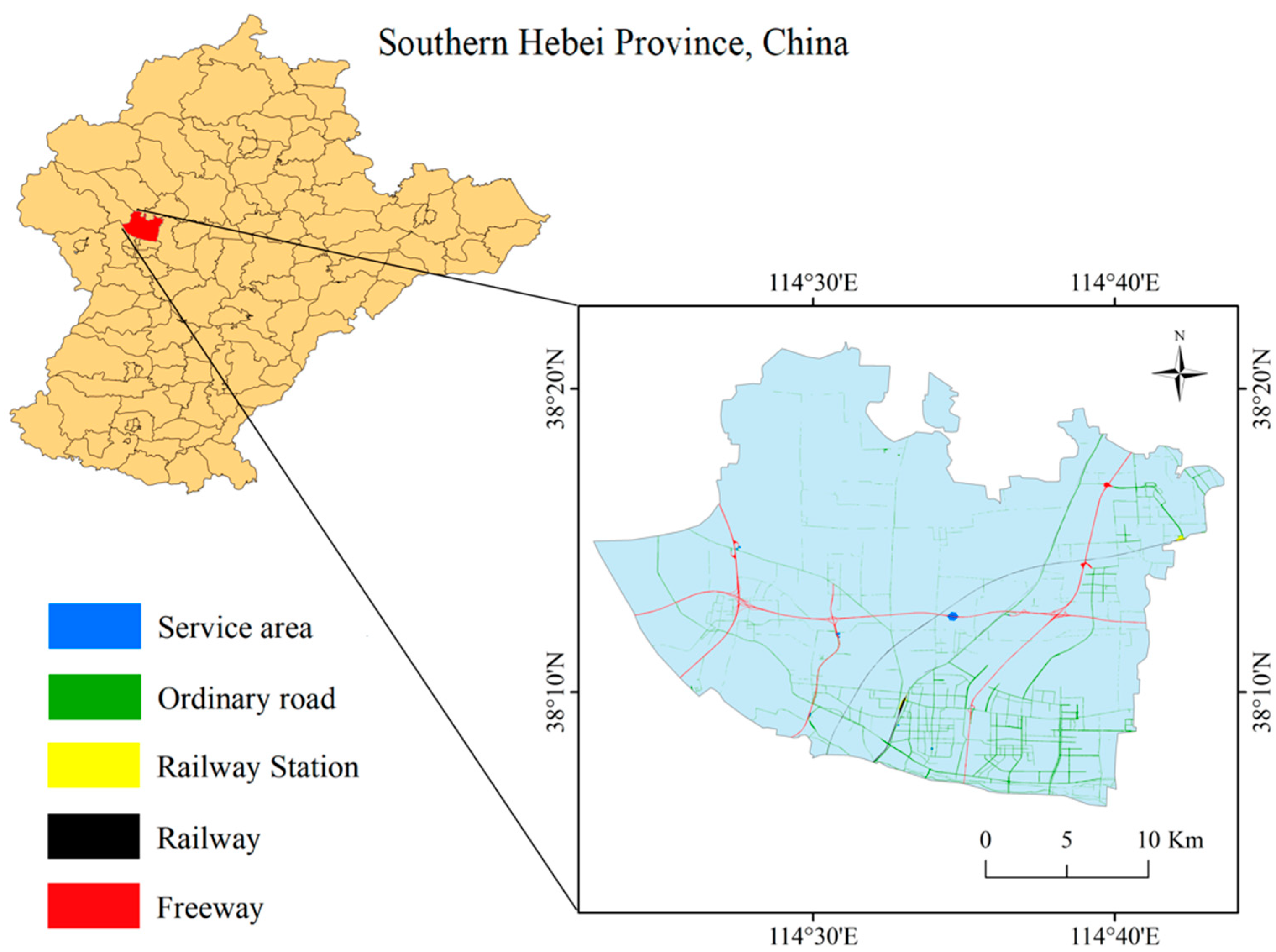
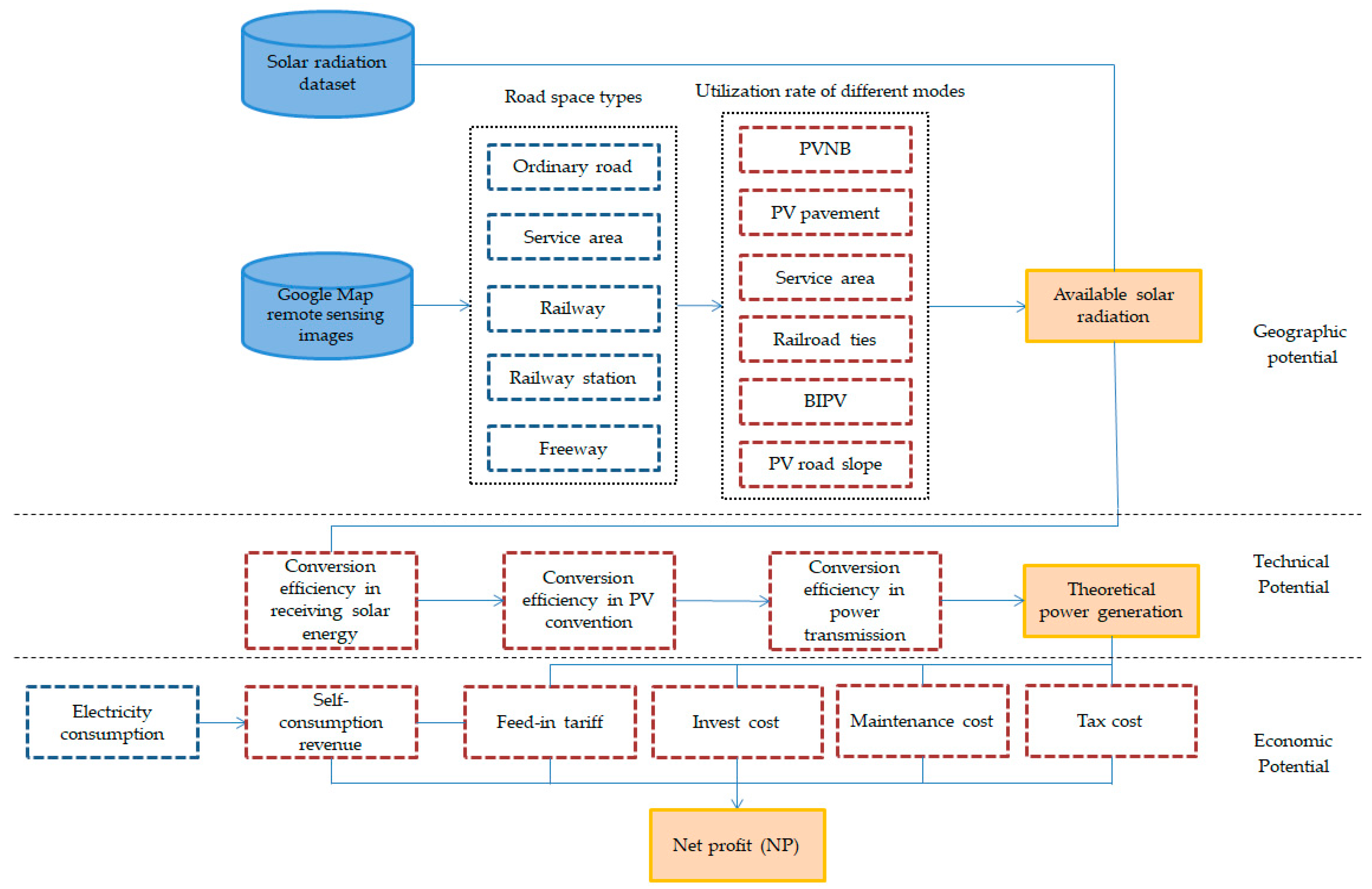

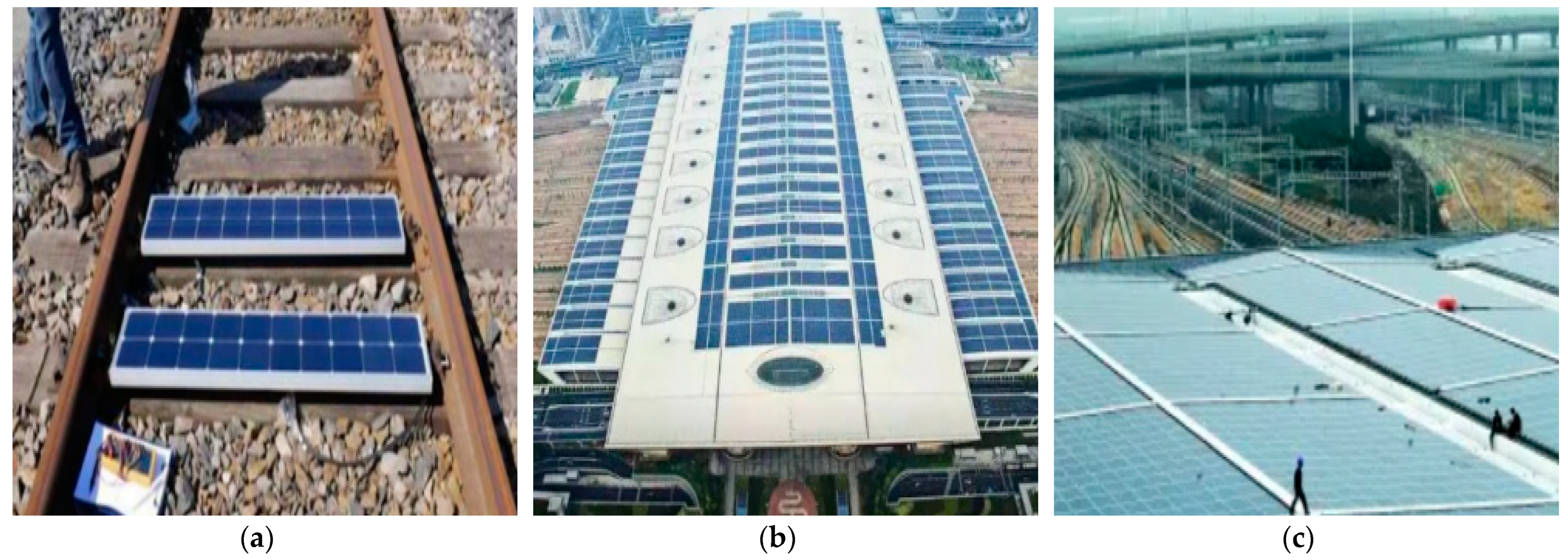
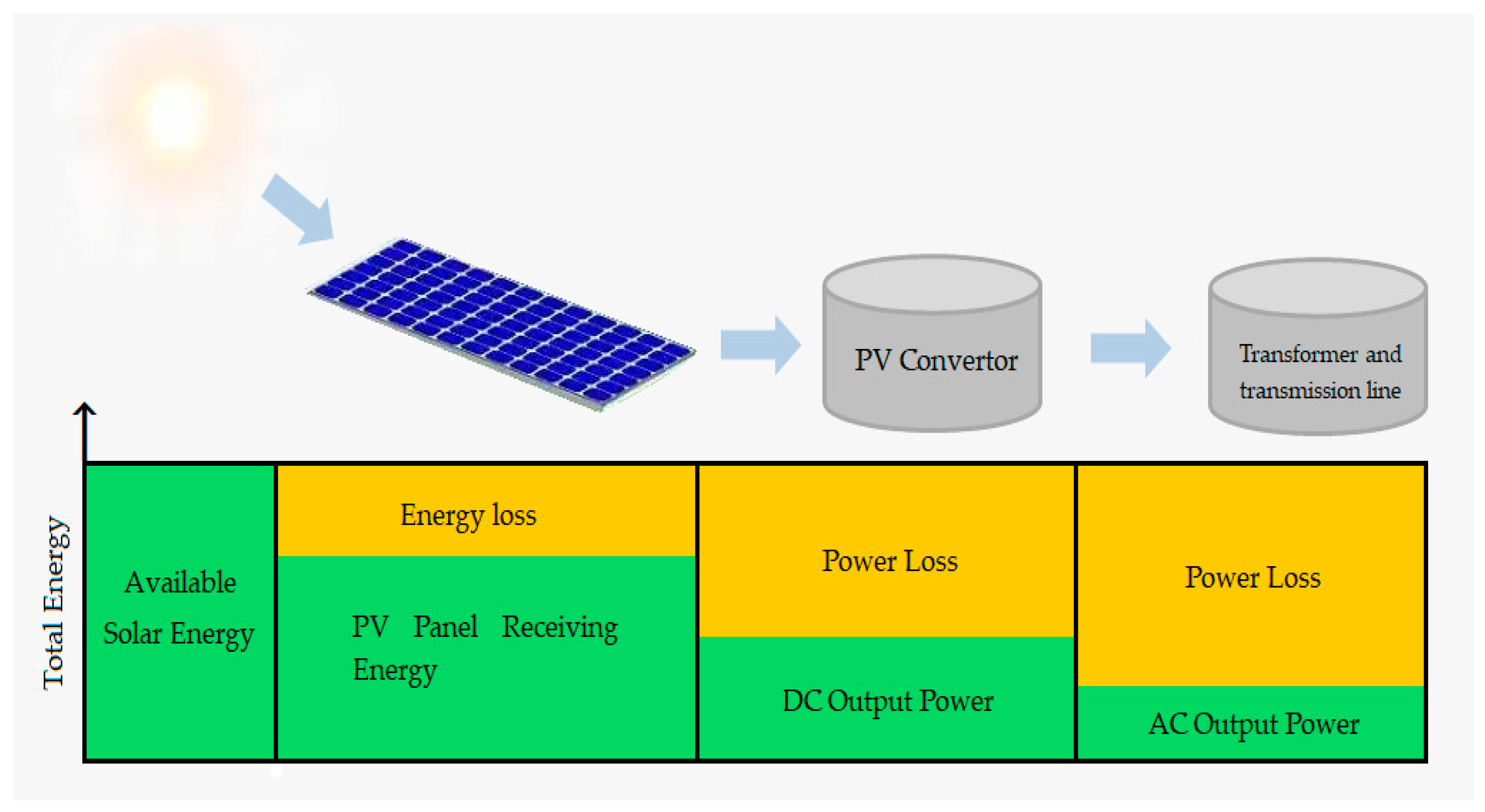

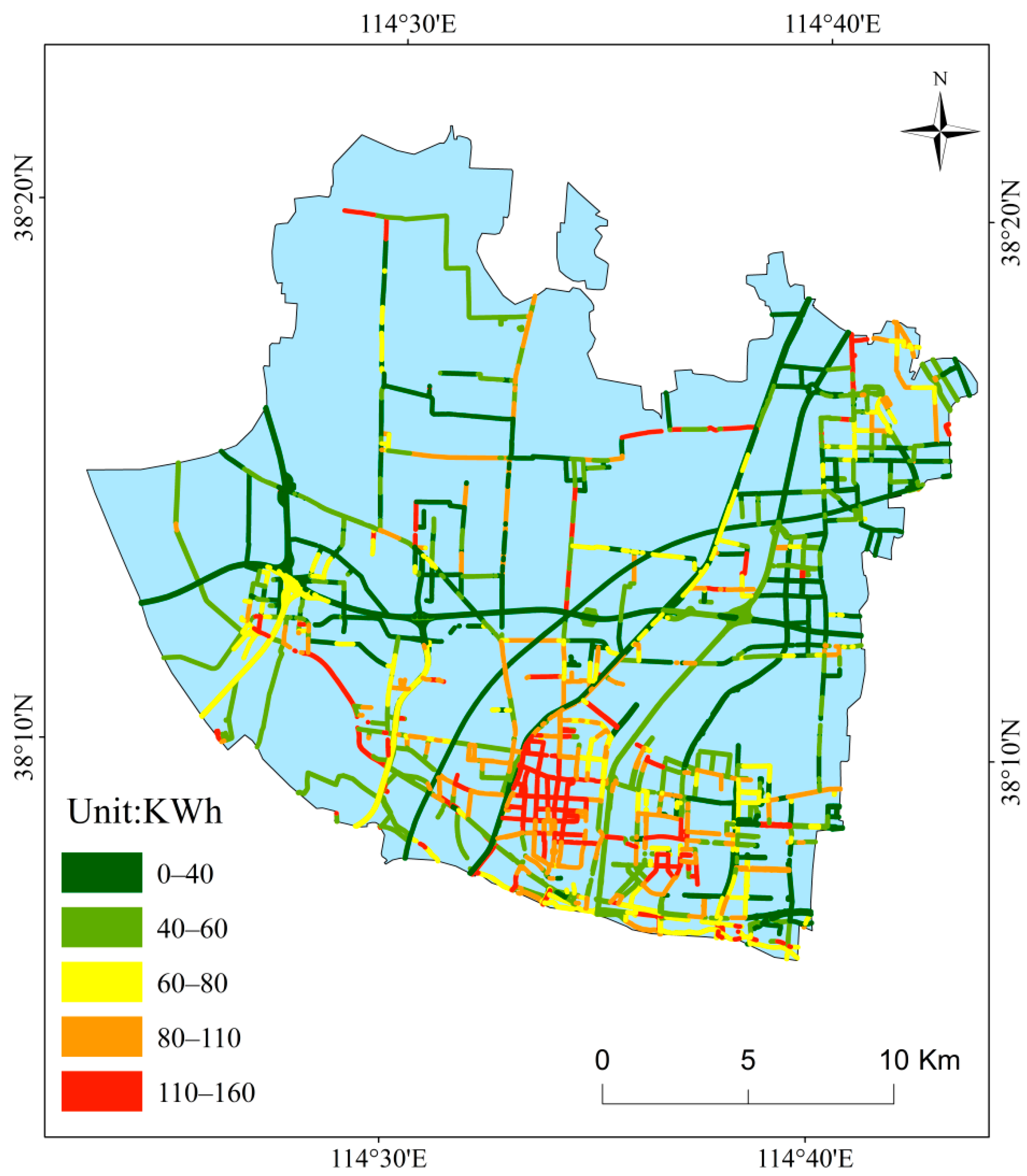

| Road Type | PV Installation Mode | Available Area (m2) | Utilization Rate (αi) |
|---|---|---|---|
| Freeway | PV road slope | Ai = S × 5 | 75% |
| ORNA | PV pavement | Ai = S | 46% |
| ORDA | PVNB | Ai = L × 2 | 98% |
| Factors that Weaken Solar Radiation | η1 |
|---|---|
| Traffic flow | 97.4% |
| Dust | 94.0% |
| Unavailable radiation | 98.0% |
| Solar radiation angle | −0.00001933x2 − 0.0002406x + 1.001 1 |
| Vegetation shading | 1− FVC |
| Economical Parameters | Computational Formula |
|---|---|
| Rcon | 0.1 × Econ × Y 1 |
| Rfeed-in | 0.13 × (ET − Econ) × Y |
| Cinv | INV × EP × Y 2 |
| Cmaint | 0.007 × EP × Y |
| Ctax | VAT + PIT + SD3 |
| Types | Road Space Area (m²) | Effective Available Area (m²) |
|---|---|---|
| Freeway | 2,838,733 | 9,669,233 |
| Ordinary road | 10,011,639 | 10,913,791 |
| Service area | 248,291 | 211,047 |
| Railway | 585,505 | 158,086 |
| Railway station | 105,856 | 31,757 |
| Total area | 13,790,024 | 20,983,914 |
| Road Type | PV Installation Mode | Power Generation (1 Million kWh) |
|---|---|---|
| Freeway | PV road slope | 542.73 |
| ORNA | PV pavement | 353.39 |
| ORDA | PVNB | 578.41 |
| Service area | Service area | 13.04 |
| Railway | Railroad ties | 14.66 |
| Railway station | BIPV | 3.65 |
| Total | 1505.88 |
Publisher’s Note: MDPI stays neutral with regard to jurisdictional claims in published maps and institutional affiliations. |
© 2022 by the authors. Licensee MDPI, Basel, Switzerland. This article is an open access article distributed under the terms and conditions of the Creative Commons Attribution (CC BY) license (https://creativecommons.org/licenses/by/4.0/).
Share and Cite
Hu, M.; Song, X.; Bao, Z.; Liu, Z.; Wei, M.; Huang, Y. Evaluation of the Economic Potential of Photovoltaic Power Generation in Road Spaces. Energies 2022, 15, 6408. https://doi.org/10.3390/en15176408
Hu M, Song X, Bao Z, Liu Z, Wei M, Huang Y. Evaluation of the Economic Potential of Photovoltaic Power Generation in Road Spaces. Energies. 2022; 15(17):6408. https://doi.org/10.3390/en15176408
Chicago/Turabian StyleHu, Mengjin, Xiaoyang Song, Zhongxu Bao, Zhao Liu, Mengju Wei, and Yaohuan Huang. 2022. "Evaluation of the Economic Potential of Photovoltaic Power Generation in Road Spaces" Energies 15, no. 17: 6408. https://doi.org/10.3390/en15176408
APA StyleHu, M., Song, X., Bao, Z., Liu, Z., Wei, M., & Huang, Y. (2022). Evaluation of the Economic Potential of Photovoltaic Power Generation in Road Spaces. Energies, 15(17), 6408. https://doi.org/10.3390/en15176408






